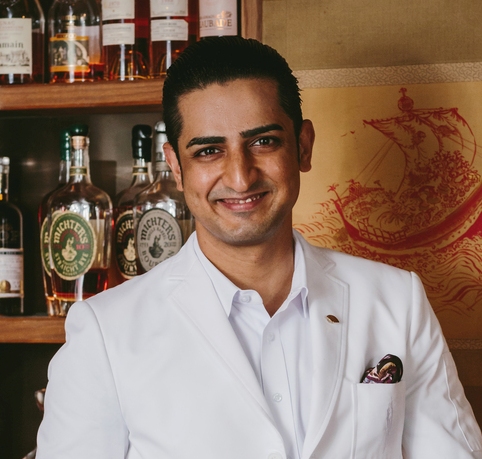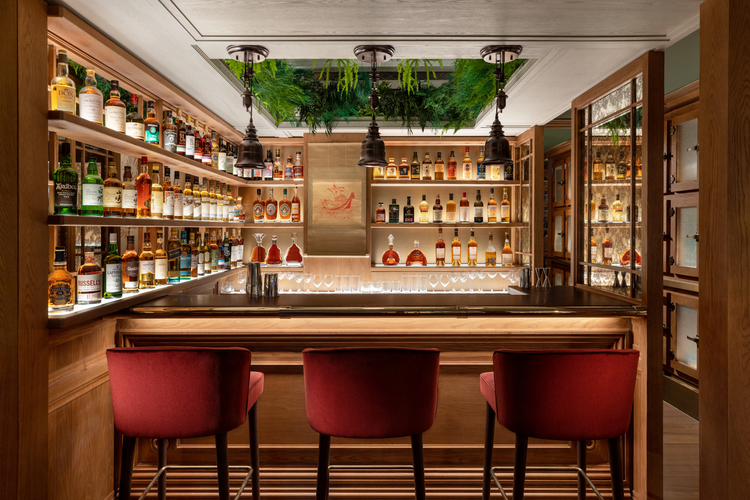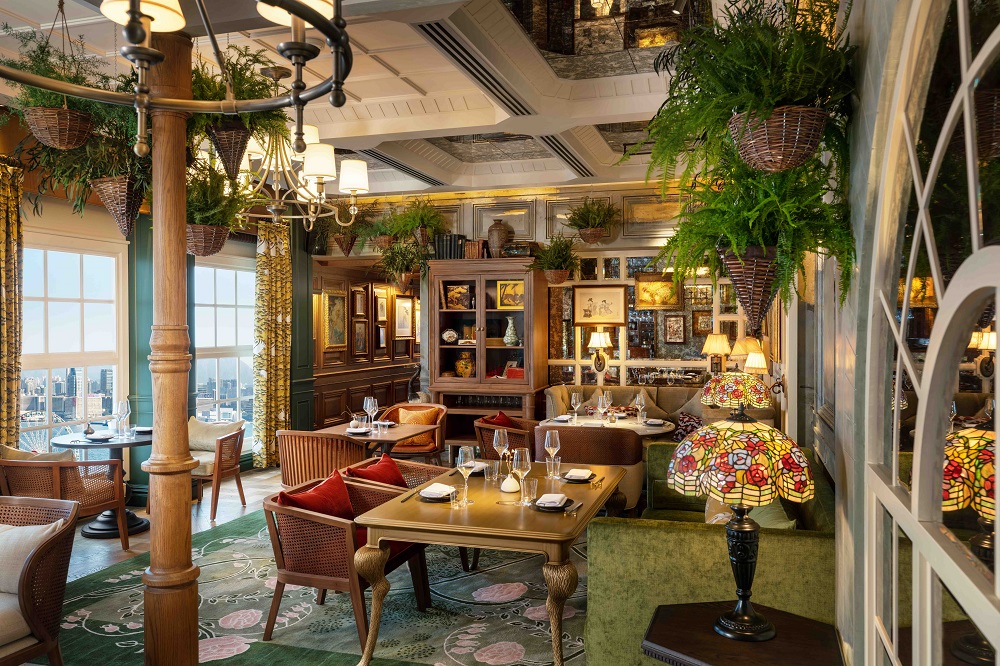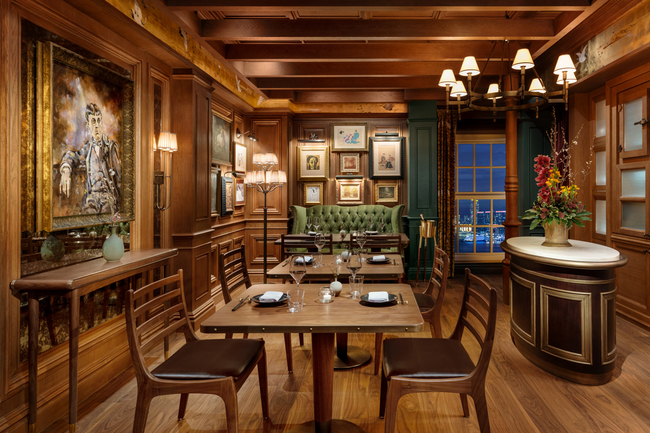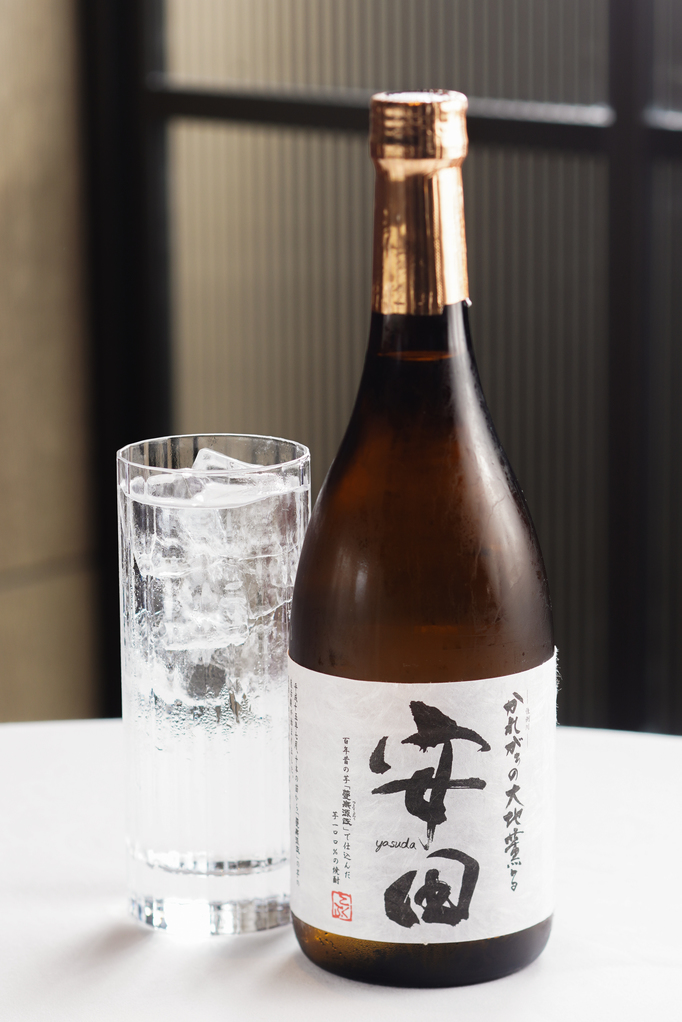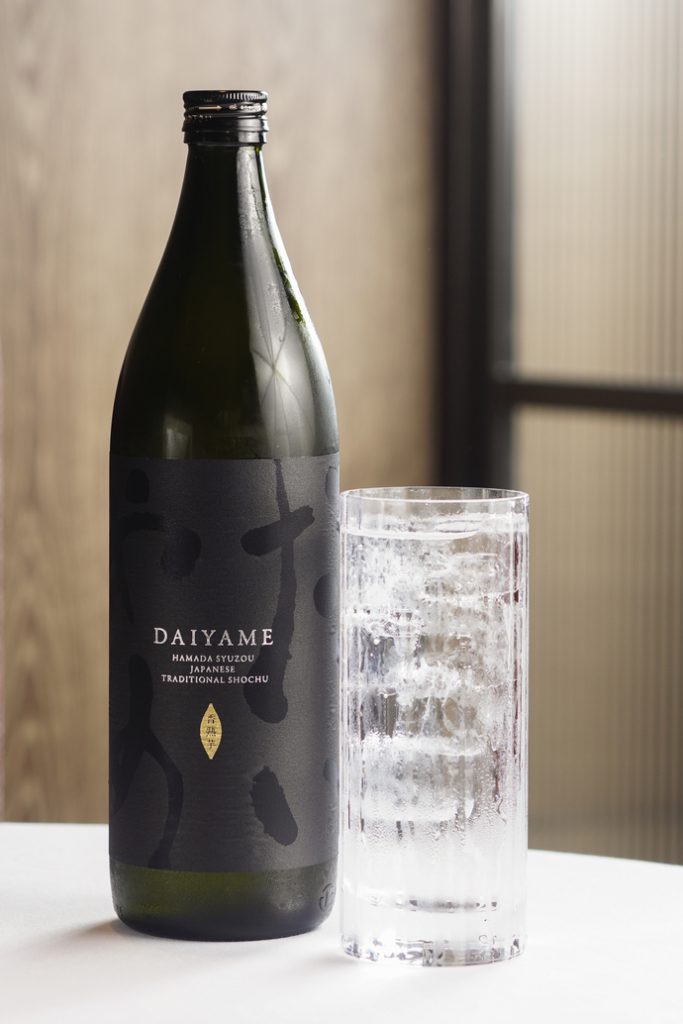The assistant general manager of The Aubrey is a big fan of Japan’s best-loved yet relatively unknown spirit, and is using it to create cocktails that highlight its myriad flavours and bring it to the attention of those looking for new taste experiences.

Located on the 25th floor of the Mandarin Oriental, The Aubrey is a self-described eccentric Japanese izakaya that channels the home of a 19th century European art collector interested in Japonisme – European artists’ works influenced by Japanese art.
It features three rooms: the main bar which has an intimate four-person omakase cocktail bar, a curio lounge with a champagne and sake bar, and a dining room replete with a portrait of the English illustrator Aubrey Beardsley, whose black-ink drawings were inspired by Japonisme.
The bar programme is helmed by Devender Sehgal, who has worked in the bar industry for 15 years. He left his home country India where he worked at top bars to come to Hong Kong in 2014 and has established a reputation as one of the city’s most affable hospitality personalities.
Devender is an avid traveller and has visited Japan numerous times. “Tokyo is fantastic,” he says. “But if you really want to get the feel of Japan you have to go to the islands or the countryside.”
It was on Kyushu Island – located at the southern tip of the country – where he developed his taste for shochu (pronounced show-chew), an indigenous drink that is less known outside of Japan than its internationally famous compatriot, sake. “What many people don’t know is that shochu is consumed far more than sake in Japan,” he says.
In 2019, Devender was invited on a trip organised by spirits educator and author, Philip Duff and the Japan Sake and Shochu Makers Association to visit some of the distilleries on Kyushu.
“Eight bartenders from around the world went on that trip,” he tells me. “We went to nine different distilleries and even visited a cave where shochu was resting in big clay pots. The one thing we all had in common was that none of us knew anything about shochu.”
I ask him what he thought of shochu when he first tried it. “To be honest I didn’t really like it,” he confesses. “What changed your mind?” The more I started to learn about it, the more curious I got. It also interested me because not many people know about it; it’s quite niche.”
Can you tell us more about it? “Shochu is a distilled alcoholic spirit made from a variety of different vegetables and grains, with the most common being rice (kome), barley (mugi) and sweet potato (imo).” Others include buckwheat, carrots, chestnuts and shisho.
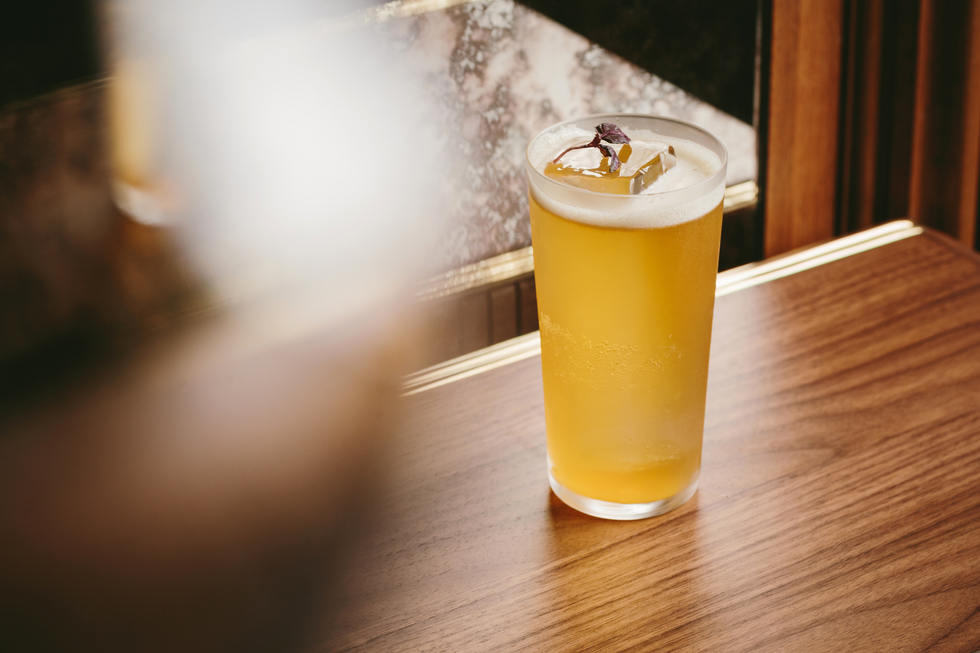
From the signature cocktail menu: The First Move, made with barley shochu, jasmine, shiso, aerated water and citrus
Shochu dates back 500 years and there are more than 500 distilleries across Japan. Approximately 300 of them are located in Kyushu – hence its name “Shochu Kingdom” – predominantly in Kagoshima.
Devender points out that many of these have geographical indications (GIs) from the World Trade Organisation. The three main areas are: Iki Island in Nagasaki, Kuma in Southern Kumamoto, and Satsuma (the traditional name for Kagoshima). Similar to wine made in Champagne, these GIs indicate location and quality standards.
“At The Aubrey we have what is called honkaku shochu. This means it is authentic and only distilled once. And that the entire process is closely monitored, from the quality of the main ingredient, to the distillation process and where the water comes from,” he explains.
“You know you’re getting quality and quite often it’s made in small batches or is limited. There are shochus that are distilled more than once, but to me, they lose their underlying flavour. So I prefer working with honkaku shochu.”
Key to the shochu-making process is koji mould. “Koji was discovered in Japan many thousands of years ago and is used to make the likes of soy sauce and miso. In general, white and yellow koji are used for shochu, although black koji can also be used. Koji is also now used in making Japanese whisky.”
Typical Shochu-making Process
Koji is mixed into washed and steamed rice and left to grow for around two days. This is then added to water and yeast to ferment for about a week. Then raw grains or vegetables are added. After 10 to 14 days, it goes into the pot still for distillation. Unrefined shochu is casked and aged for one to three months. It is usually bottled at around 25% to 30% ABV – by law it cannot be more than 45%. Shochu has no sugar, carbohydrates or gluten, and is low in calories.
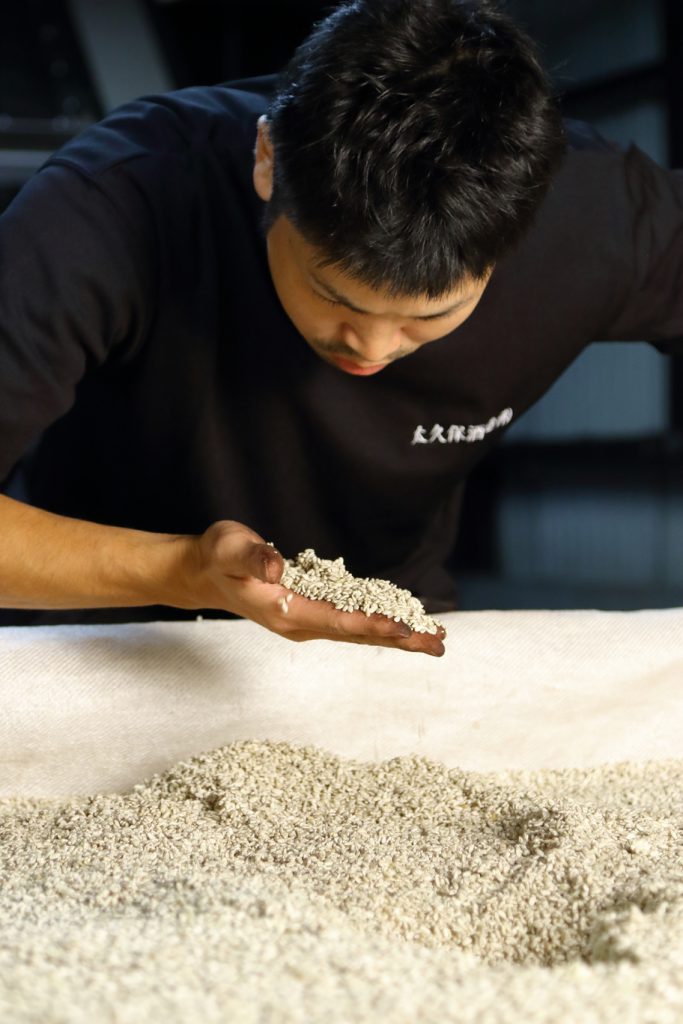
Koji & Rice Photo: Ookubo Shuzo, Kagoshima, Japan
The origins of how shochu’s distillation technique arrived in Japan vary, but one theory is that it came via Persia in the 16th century, going through Okinawa – where shochu was known as awamori – before landing in Kagoshima. “Awamori was around before shochu and is the oldest distilled beverage in Japan,” Devender tells me.
“Shochu can actually be made anywhere in the world. They make it in the US,” he says. “But, awamori can only come from Okinawa because of its GI. And, it can only be made with black koji and Thai long-grain rice [Indica]. There is only a one-step fermentation process and it’s only distilled once.”
Awamori is usually stored in a clay pot or bottle for three or more years to mature. The longer it sleeps, the sweeter and richer its flavours become and the more mellow its mouthfeel.
Cocktail menus at The Aubrey – the seasonal which currently features Japanese pears and the signature with drinks based on moves in the game of chess – include libations made with awamori.
“We have a cocktail made with awamori, melon and mescal,” Devender says. “Mescal can be a bit aggressive and smoky but it comes across so nicely; the awamori helps it shine through. Awamori can be a supportive ingredient or a hero, depending on the direction you want to take it.
“One thing I love about shochu is that it is 25% ABV but is incredibly flavourful. You can use it with something else like vodka to increase the ABV and they can work together.”
The aromas and tastes of shochus vary wildly – from light, delicate, fruity, floral, nutty and with different degrees of earthiness to full-on funky and umami – and no two made from the same vegetable or grain are alike. Their many expressions make it an extremely versatile spirit that is great for making cocktails.
It can also be drunk neat, with cold water (mizuwari), hot water (oyuwari), with soda water, fruit juice and even tea.
I tried two imo sochus with Devender, both from Kakoshima and both neat. First, Yasuda. “This brand grows the koji on the sweet potato, which is slightly difficult,” he explains. “It is incredibly flowery on the nose but not on the palate; it’s quite dry and not very sweet.” I found it light, elegant, fruity and extremely drinkable.
Next, Daiyame. “They use black koji in this. The nose is like a bouquet of lychees, but there’s no lychees in it! What they do is ripen the sweet potato for longer and that develops a new flavour.” Indeed, lychees on the nose. On the palate, sweet and crisp – and unexpectedly moreish!
“I’ve been working on new cocktails for the new year,” Devender shares. “One using Daiyame with sherry. Another with brown sugar (kokutu) shochu, which is only made on an island called Amami Oshima, which has a GI. There are only seven distilleries there. This shochu is very niche and special for us to have.”
The more you dip into shochu and awamori, the more there is to explore. To learn more, Devender suggests listening to podcasts by Stephen Lyman and Christopher Pellegrini (japandistilled), who have also written books.
You could also head up to The Aubrey and chat to Devender, who is passionate about shochu – and try his cocktails and pretend you’re in Japan.
“I believe in the next 10 years shochu is going to be one of the biggest categories of spirits in the world and that it has the possibility to be as big in cocktails as gin or vodka,” he says. “The world of shocus is exciting.”
We don’t doubt him. Kanpai!

